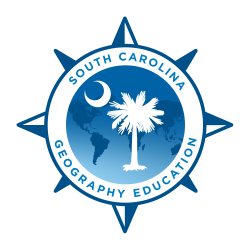Activities
SCGeo-developed activities and lesson strategies are found here. Accordion links include lesson strategies organized by geographic theme.
Standards & Important Documents
-
Click Here for a PDF of the SCSSCCR Standards from 2019.
-
Grade 3 World Geography Alignment Guide
Grade 7 Geography of World Regions Alignment Guide
Human Geography Alignment Guide
-
These progressions use kid-friendly language to empower students and teachers to make informed decisions about their learning in connection to each geographic theme and skill. These progressions can be used as a tool for self-assessment, conferencing, feedback, goal setting, small group lesson planning, peer feedback, and more.
Click Here to access the progression.
Have a lesson you’d like to share?
Send your lesson plan to us at scgeographicalliance@gmail.com using the template below! We’d love to hear from you and consider publishing your teaching strategies.
Applied Geography
-
Aligned with Indicator 3.1.1.AG.
Click Here to access these resources.
-
Aligned with Indicator 3.1.2.AG.
Click Here to access this resource.
-
Aligned with Indicator 3.1.2.AG. Click Here to access the activity.
-
The concept of scale is often difficult for younger students. Our world is arranged in a number of spatial hierarchies, some physical (e.g. watersheds) and some social (e.g. political units).
This simple front-back sheet of people allows students to understand how their home fits within counties, states, countries, continents, and the world. To use, fold the paper in half 4 times. Beginning with "Community", the student unfolds the sheet to locate themselves within this 'nesting' of geographic units.
Click Here to access this resources. This two-page PDF fill will need to be printed on both sides of a single sheet of paper.
-
Blank outline maps of the United States and each state.
Click Here to access this resource.
-
Blank maps of the world, the United States, Southeast Asia, South-central Asia, South America, the Pacific Rim, North America, the Middle East, Middle America, Mexico, Latin America, the Former Soviet Union, Europe, Central Europe, Canada, Australia and New Zealand, Asia, and Africa.
Click Here for access to this folder.
-
Blank outline and labeled maps of South Carolina, focusing on different human and physical features.
Click here for access to this folder.
-
Create and analyze a foldable map to learn about coordinates and map projections.
Click here for access to this folder.
Environment and Resources
-
This lesson strategy is aligned with Indicators 7.1.1.PR, 7.1.2.ER, and 7.1.3.HS.
Using GIS, students learn how physical systems can impact human activities in similar and unique ways across various regions.
Click Here to access this lesson.
-
This resource is aligned with Indicators 7.5.1.PR and 7.5.2ER.
Click Here to access this lesson.
-
This lesson is aligned with Indicators 7.3.1.PR, 7.3.2.ER, and 7.3.5.HS.
Click Here to access this lesson strategy.
Human Systems
-
This lesson strategy is aligned with Indicators 7.2.1.PR and 7.2.3.HS.
This activity encourages students to investigate how populations vary due to human and physical conditions in places, and how population movement connects places.
Click Here to access this resource.
-
This resource is aligned with Indicators 7.3.1.PR and 7.3.4.HS.
Using this resource, students will analyze song lyrics, map demographic data, and read various articles focused on the history of Aboriginal people.
Click Here to access this lesson strategy.
-
This lesson strategy is aligned with Indicators 7.6.1.PR and 7.6.4.HS.
This resource encourages students to explore the religions of South America, allowing for greater understanding of religion as an expression of cultural diversity.
Click Here to access this lesson.
-
This resource is aligned with Indicators 7.5.1.PR and 7.5.5.HS.
Click Here to access this lesson strategy.
-
This lesson is aligned with Indicators 7.4.1.PR and 7.4.3.HS.
Click Here to access this resource.
Places and Regions
-
Students read texts and maps to learn about physical characteristics of islands of Oceania and Australia.
Click here to access this lesson.
-
Use a variety of maps and resources to explore South Carolina sites with connections to history, geology, culture, business, and more. These seven updated activities are based on the South Carolina Maps and Aerial Photographic Systems project.
CLICK HERE TO ACCESS FOLDER
